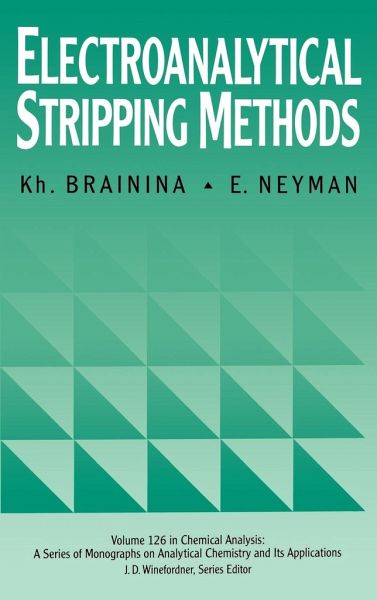
Electroanalytical Stripping Methods
Versandkostenfrei!
Versandfertig in über 4 Wochen
193,99 €
inkl. MwSt.

PAYBACK Punkte
97 °P sammeln!
Incorporating the latest theoretical and experimental developments in the field over the past decade, Brainina and Neyman's Electroanalytical Stripping Methods focuses on the theory associated with the most progressive stripping electroanalytical methods (SEAMs) and their application to environmental monitoring and industry. Wherever appropriate, it highlights the main advantages of these methods, including their extremely low detection limit, the low cost of the instruments used, the possibility of speciation analysis, and their use in the investigation of solids as well as solutions. The com...
Incorporating the latest theoretical and experimental developments in the field over the past decade, Brainina and Neyman's Electroanalytical Stripping Methods focuses on the theory associated with the most progressive stripping electroanalytical methods (SEAMs) and their application to environmental monitoring and industry. Wherever appropriate, it highlights the main advantages of these methods, including their extremely low detection limit, the low cost of the instruments used, the possibility of speciation analysis, and their use in the investigation of solids as well as solutions. The combined work of two eminent researchers from the former Soviet Union, the book closes the previous information gap that existed between West and East and now makes accessible the most recent developments from Russia, including a different approach to initial electro-crystallization stages, the interconnection between voltammograms of binary metal systems and work functions, and the use of these phenomena in applied stripping voltammetry. Electroanalytical Stripping Methods also provides a critical assessment of current achievements in the field of electrode materials, and in the design of electrodes and electrochemical cells used in stripping methods. Here, the authors provide unique insight into the advantages of graphite electrodes - largely used in the East - over glassy carbon electrodes generally favored by the West. The book presents a number of other modern ideas, including the theory behind and the application of a new internal standard in stripping voltammetry...the catalysis of metals electrodeposition on the foreign substrate with adatoms...and the electrochemical transformation of solidsand adsorbates and their use in phase analysis and the investigation of the defect structure of solids. Electroanalytical Stripping Methods will prove to be an invaluable tool for professionals involved in environmental monitoring, helping them to develop and use trace analysis in evaluating drinking water, food, waste, and other solids and solutions and to apply stripping voltammetry to the analyses of chemicals. Researchers in the food, clinical, and pharmaceutical industries will similarly use the book to develop and apply SEAMs for trace analysis. Practitioners in the microelectronics industry will find useful information on solids that will help them improve the quality of catalyzers, films, special ceramics, and semiconductors. Finally, medical technicians will tap this resource for the insight it can provide in the electroanalysis of blood, urine, and other body fluids.




